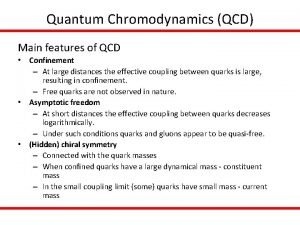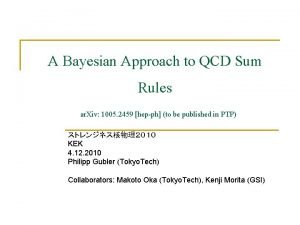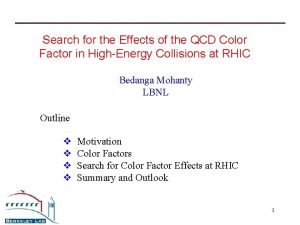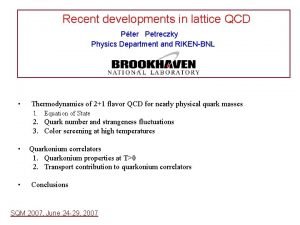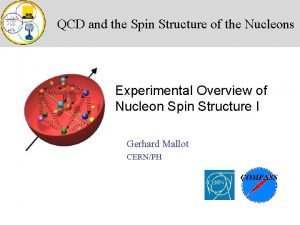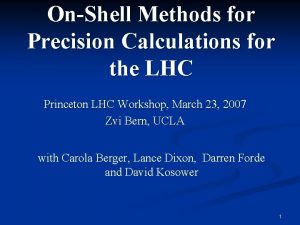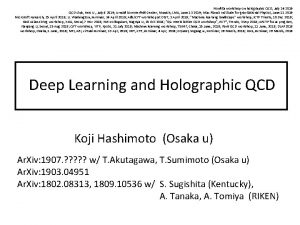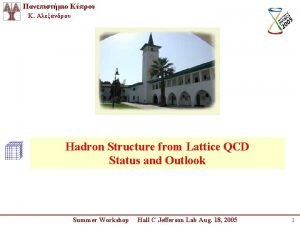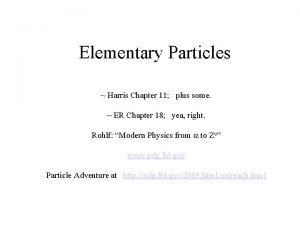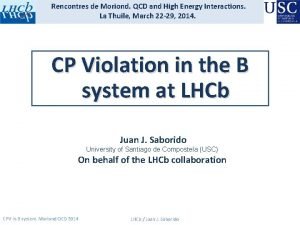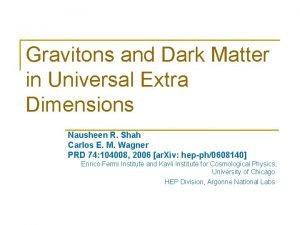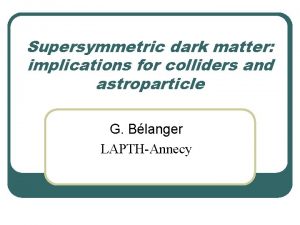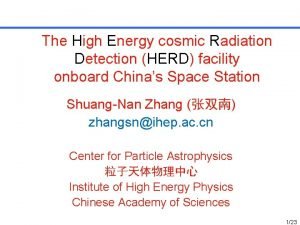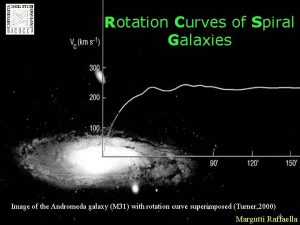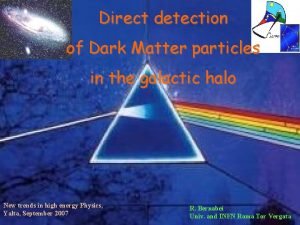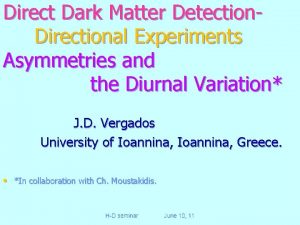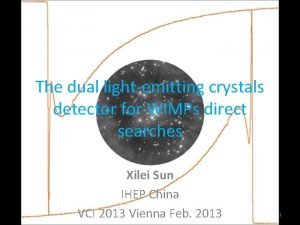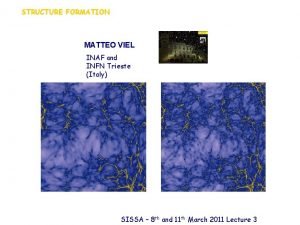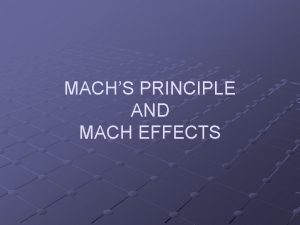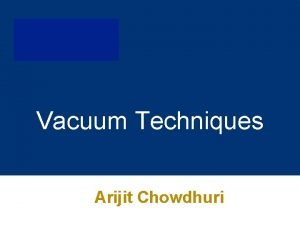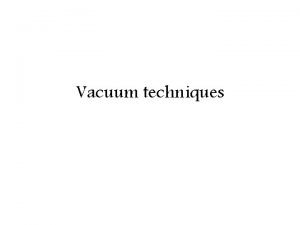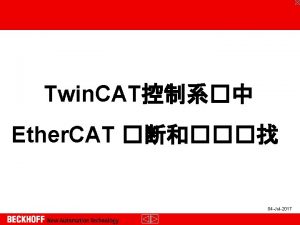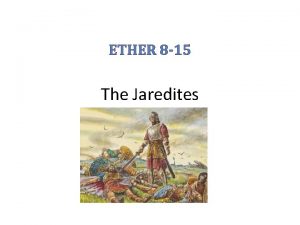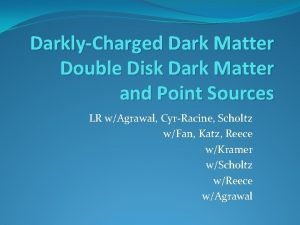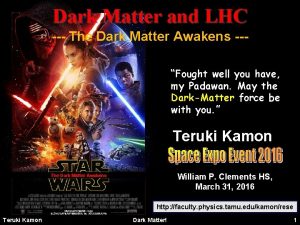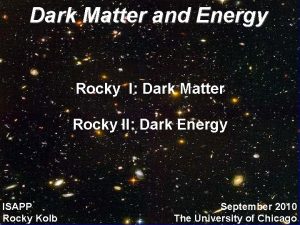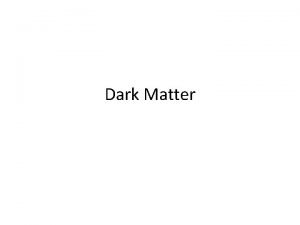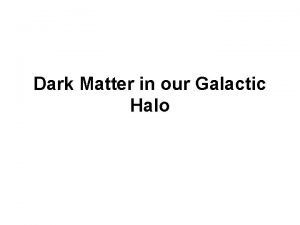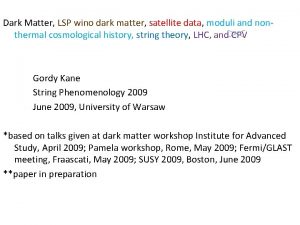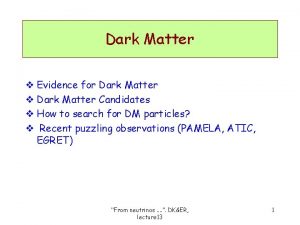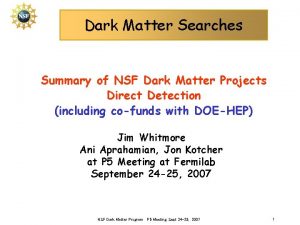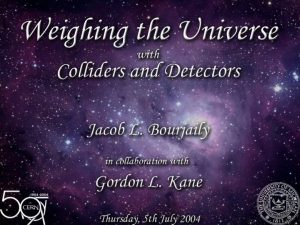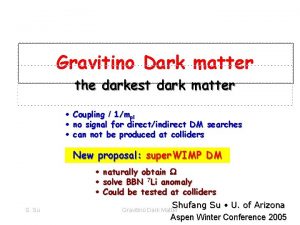Dark matter Machs ether and the QCD vacuum






















- Slides: 22

Dark matter, Mach’s ether, and the QCD vacuum Ar. Xiv: 1507. 00460 v 2 Gilles Cohen-Tannoudji (LARSIM CEA Saclay) LISHEP 2015 04/07/2015 04/08/2015 DM as QCD vacuum 1

Outline • Einstein’s address at the Leiden university, may 1920: search for a Mach’s ether for general relativity • LCDM and the dark matter issue • The QCD vacuum in a cosmological context • The hypothesis I submit to debate: Dark energy + Dark matter = Mach’s ether Dark matter = QCD vacuum 04/08/2015 DM as QCD vacuum 2

The Mach’s ether of general relativity 04/08/2015 DM as QCD vacuum 3

Albert Einstein An address delivered in 1920, at the University of Leiden It is true that Mach tried to avoid having to accept as real something which is not observable by endeavoring to substitute in mechanics a mean acceleration with reference to the totality of the masses in the universe in place of an acceleration with reference to absolute space. But inertial resistance opposed to relative acceleration of distant masses presupposes action at a distance; and as the modern physicist does not believe that he may accept this action at a distance, he comes back once more, if he follows Mach, to the ether, which has to serve as medium for the effects of inertia. But this conception of the ether to which we are led by Mach's way of thinking differs essentially from the ether as conceived by Newton, by Fresnel, and by Lorentz. Mach's ether not only conditions the behavior of inert masses, but is also conditioned in its state by them. 04/08/2015 DM as QCD vacuum 4

If we consider the gravitational field and the electromagnetic field from the standpoint of the ether hypothesis, we find a remarkable difference between the two. There can be no space nor any part of space without gravitational potentials; for these confer upon space its metrical qualities, without which it cannot be imagined at all. The existence of the gravitational field is inseparably bound up with the existence of space. (…) From the present state of theory it looks as if the electromagnetic field, as opposed to the gravitational field, rests upon an entirely new formal motif, as though nature might just as well have endowed the gravitational ether with fields of quite another type, for example, with fields of a scalar potential, instead of fields of the electromagnetic type. 04/08/2015 DM as QCD vacuum 5

Recapitulating, we may say that according to the general theory of relativity space is endowed with physical qualities; in this sense, therefore, there exists an ether. According to the general theory of relativity space without ether is unthinkable; for in such space there not only would be no propagation of light, but also no possibility of existence for standards of space and time (measuring rods and clocks), nor therefore any space time intervals in the physical sense. But this ether may not be thought of as endowed with the quality characteristic of ponderable media, as consisting of parts which may be tracked through time. The idea of motion may not be applied to it. 04/08/2015 DM as QCD vacuum 6

An observational evidence for the Mach’s ether: dark matter in astrophysics and cosmology 04/08/2015 DM as QCD vacuum 7

Dark matter in astrophysics Rotation curves of stars in galaxies and galaxies in clusters of galaxies Rotation velocities do not decrease with distance at large distance Dark matter invented to address this issue: a medium that exerts a gravitational force that compensate the centrifugal force and prevent the rotating object to escape from the system in which it rotates Centrifugal force Fc=mv 2/r , compensated by gravitational force M(r)m/r 2 if M(r)=lr i. e. the force exerted by a string with constant (independent of m and of r) string tension Dark matter acts as an ether exerting a gravitational force which derives from a scalar potential 04/08/2015 DM as QCD vacuum 8

Dark matter in cosmology: Review of the LCDM standard model (WMAP confirmed by Planck 2015) • Planck 2015 results: · The Planck TT, TE, and EE spectra are accurately described with a purely adiabatic spectrum of fluctuations with a spectral tilt ns = 0. 968 ± 0. 006, consistent with the predictions of single-field inflationary models. Combining Planck data with BAO, we find tight limits on the spatial curvature of the Universe, Wk<0. OO 5, again consistent with the inflationary prediction of a spatially flat Universe. · By combining the Planck TT+low. P+lensing data with other astrophysical data, including the JLA supernovae, the equation of state for dark energy is constrained to w = 1. 006 ± 0. 045 and is therefore compatible with a cosmological constant, as assumed in the base LCDM cosmology. 04/08/2015 DM as QCD vacuum 9

Late inflation, CC dominance era Primordial inflation Today, a = 1 04/08/2015 DM as QCD vacuum 10

The three stages of the LCDM model Hubble radius L vs scale parameter a (set at 1 today) in log scale • Primordial inflation from a = 0 to point X. Between point P and point X about 30 orders of magnitudes: at point X space is already flat. • Hubble expansion between point X and point Y: era with L as a 2 (radiation dominance) followed by era with L as a 1. 5 (matter dominance) • Late inflation, CC dominated between point Y and point Q 04/08/2015 DM as QCD vacuum 11

04/08/2015 DM as QCD vacuum 12

A theoretical hint about the Mach’s ether: the quantum vacuum 04/08/2015 DM as QCD vacuum 13

04/08/2015 DM as QCD vacuum 14

The quantum vacuum is not the nothingness « D'où l'on peut voir qu'il y autant de différence entre le néant et l'espace vide, que de l'espace vide au corps matériel ; et qu'ainsi l'espace vide tient le milieu entre le matière et le néant. » Réponse de Blaise Pascal au très révérend père Noël, recteur de la Société de Jésus, à Paris, 29 octobre 1647 Pascal, Oeuvres complètes, La Pléiade, p 384, ed. 1998 04/08/2015 DM as QCD vacuum 15

Consequences of the Heisenberg inequalities • When the number of particles is well determined (for instance in the quantum vacuum where this number is zero) the space-time state of the fields is not determined: they fluctuate • In space-time, the quantum vacuum can be assimilated to a complex medium, seat of non scale invariant quantum fluctuations of the fields • The properties of the quantum vacuum depend on the scale at which it is probed. In cosmology, this scale is provided by the horizon radius which depends on the cosmic time. • If Mach’s ether is to be assimilated to the quantum vacuum, it has to depend on the cosmic time 04/08/2015 DM as QCD vacuum 16

Primordial inflation and the Brout Englert Gunzig mechanism In the model proposed by Brout, Englert and Gunzig which could be compatible with the primordial inflation phase of LCDM “quantum creation of massy particles can occur in the cosmological context without cost of energy” R. Brout, F. Englert and E. Gunzig, The Creation of the Universe as a Quantum Phenomenon, Annals of Physics 115, 78 106 (1978) (The BEG mechanism ! ) The main point of their argument is that in homogeneous and isotropic cosmologies that obey the cosmological principle, the metric is conformally flat, i. e. such that it is Minkowskian up to a multiplicative factor related to its determinant which can be treated as a scalar field f in Minkowski (flat) space time. This field gives rise to a negative energy density such that matter carrying positive energy can be created and yet the total energy can be kept fixed and equal to the vacuum energy. This apparent paradox is solved exactly in the same away as in the Brout Englert Higgs mechanism electroweak symmetry breaking, the ghost that appears in the Landau ‘t. Hooft gauge is canceled by the Nambu Goldstone boson in the unitary gauge. 04/08/2015 DM as QCD vacuum 17

The QCD vacuum as an ether The QCD Lagrangian, without quarks or with massless quarks (in the so called chiral limit), is scale invariant since the coupling constant is dimensionless. But through quantization, this symmetry is broken, one says that it is dynamically broken: this phenomenon is called conformal anomaly. The dynamical breaking of scale invariance is apparent in the fact that “the renormalization has replaced a one parameter family of unrenormalized theories, characterized by their values of the dimensionless unrenormalized gauge coupling, g 0 , by a one parameter family of renormalized theories, characterized by their value of the dimension one [renormalization group invariant] scale mass M(g, m)” (Stephen L. Adler, Einstein gravity as a symmetry breaking effect in quantum field theory Review of Modern Physics, Vol 54, No 3, 729, 1982). This feature is also known as dimensional transmutation This scale mass, independent of the energy m at which renormalization is performed, appears as a non vanishing trace of the renormalized energy momentum tensor; it is completely physical; it is related to the hadron masses; but, and this is the main point of our proposal, it does have cosmological implications. Since the variation of the action with respect to the metric, is proportional to the energy momentum tensor, the scale factor of the metric, represented by a scalar field f, is proportional to the trace of the energy momentum tensor, 04/08/2015 DM as QCD vacuum 18

Color confinement in QCD Confinement superconductivity analogy QCD vacuum = perfect color diaelectric e=1 Superconductor = perfect diamagnetic m=1 e=0 m=0 l= string tension 04/08/2015 19 DM as QCD vacuum

The only way for such vacuum energy densities to contribute to the dark matter density is to be non relativistic (namely cold), stable, and with only very weak non gravitational interactions. It seems possible to satisfy all these conditions with Bose Einstein Condensates (BEC): very low temperature at the Hubble horizon, superfluidity, a characteristic of BEC. It turns out that DM models involving such BECs have been successfully tried in the literature (Cosmic Structure as the Quantum Interference of a Coherent Dark Wave by Hsi Yu Schive, Tzihong Chiueh∗ & Tom Broadhurst ar. Xiv: 1406. 6586). In this reference, the authors show, by means of high precision simulations, that their Axion like model agrees with the conventional cold dark matter model in the description of large scale structures in the distribution of galaxies and works much better than the conventional one in the description of small scale structure thanks to interferences between the “dark quantum waves” and some waves arising in hydro dynamical models (Jeans effect). Apart from ultralight bosons like the hypothetical Axion or scalar bosons, relics of the GUT symmetry breaking or of some superstring dynamics, the only bosons susceptible to condense and to lead to observable cosmological effects are the photon and the gluon. In fact weak intermediate and Higgs bosons are unstable and decay into light particles in such a way that they contribute only to the radiation (or relativistic) component in the density budget of present time and are thus negligible. The photon can condense (see the Casimir effect), but again it contributes only to the radiation component and is negligible. There only remains the gluon 04/08/2015 DM as QCD vacuum 20

Hubble radius L=H 1 Future event horizon Today E LL From radiation to matter dominance D F LCDM cosmological SM Color confinement C Past event horizon HEP standard model a Linf LP w B A 10 60 Primeval inflation Big Bang ignition Expansion 1 Late inflation Scale factor BSM physics 04/08/2015 DM as QCD vacuum 21

Baryonic to dark matter energy density ratio and the quark gluon parton model Scaling observed in deep inelastic lepton nucleon scattering at the confinement scale (about 1. 5 Ge. V 2 ) leads to the parton distribution functions used as input in the standard model: • Three valence “constituent quarks” (with a mass about 1/3 of the nucleon mass) carrying about 15% of the momentum of the nucleon • “Sea” quark anti quark pairs and gluons ( that is the QCD vacuum) carrying the remaining 85% of the momentum of the nucleon Once confined, the valence quarks give rise of the baryonic matter and the QCD vacuum gives rise to the dark matter, with the good ration of energy densities Quod erat demonstrandum! 04/08/2015 DM as QCD vacuum 22
 Dark matter and dark energy presentation
Dark matter and dark energy presentation In the dark dark town
In the dark dark town Confinement qcd
Confinement qcd Qcd sum rules
Qcd sum rules Color factor qcd
Color factor qcd Qcd
Qcd Qcdsh
Qcdsh Qcd lagrangian
Qcd lagrangian Nucleon
Nucleon Qcd penrose
Qcd penrose Qcd
Qcd Qcd
Qcd Qed qcd qfd
Qed qcd qfd Rencontres de moriond
Rencontres de moriond Dark matter gravitons dimensions
Dark matter gravitons dimensions Boosted dark matter
Boosted dark matter Dark matter
Dark matter Dark matter pwo
Dark matter pwo Dark matter physics
Dark matter physics Where to stream dark matter
Where to stream dark matter What could dark matter be
What could dark matter be Dark matter
Dark matter Dark matter
Dark matter


